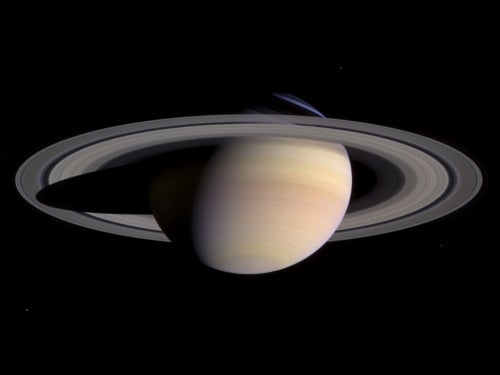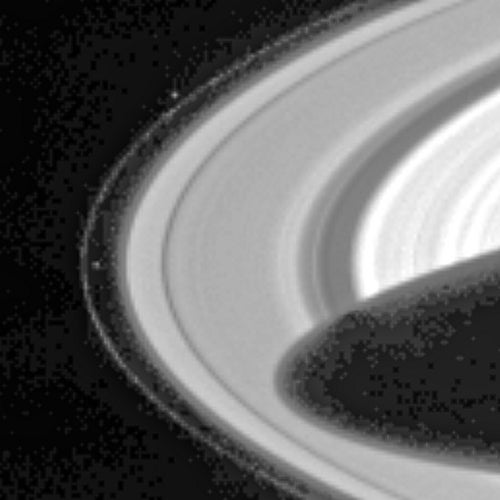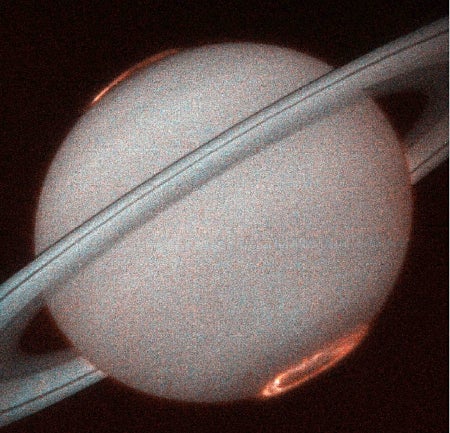The stage is set for what is expected to be the most thorough scientific study of a planet ever undertaken. The Cassini-Huygens spacecraft, which was launched in 1997 from Cape Canaveral, Florida, is now very close to reaching its final destination: Saturn. In July, Cassini will fire its rocket and enter orbit around Saturn; early next year, the Huygens probe will drop into the atmosphere of the planet’s largest moon, Titan.
“We’ve spent a lot of time on this mission,” science planner Trina Ray told Astronomy. “We’ve been seven years on our way out to Saturn, so now that things are starting to happen, it’s very exciting.”
The mission’s “cruise phase” began as soon as Cassini was Saturn-bound. Although there were a few good science opportunities, notably the Jupiter flyby in December 2000, for the most part, cruise-phase sequences were maintenance related: checking and calibrating the instruments and making sure the spacecraft actually would make it to Saturn.
With the start of sequence C42 on January 9, the mission officially entered its “approach science phase,” which will last until Saturn Orbit Insertion on June 30.
One of the first objectives of the approach science phase was to change the behavior of the spacecraft, “making sure it was at its most sophisticated,” Ray said. For example, in other sequences, Cassini maintained its orientation using pulses from small thruster rockets. Each small thrust compromises the accuracy with which the spacecraft can point its instruments. “Now that we’ve transitioned fully to tour operations, we’re on reaction wheels all the time, instead of thrusters,” she noted.
As Saturn looms larger and larger in the eyes of Cassini’s instruments, the spacecraft’s Imaging Subsystem (ISS) and Visual and Infrared Mapping Spectrometer (VIMS) have been making movies of the rings and atmosphere — and, of course, taking plenty of pictures. There are still 18.6 million miles (30 million kilometers) between the spacecraft and its target, but even at this distance, the rings are too wide for Cassini’s field of view. The last time Cassini was able to image the entire system was on March 27, from a distance of 29.7 million miles (47.7 million kilometers).
“In some sense, we started looking at Saturn as soon as we flew by Jupiter,” said project scientist Dennis Matson. “The intensity of the observations is increasing as we’re getting closer because there are more things we can do.”
“Most of what we’ve been doing since January is large system scans,” Ray said. “Saturn is far away right now, so if we do these scans back and forth across the Saturn system, we can look for things like different molecular species.”
Other objectives of the system scans include searches for new satellites by ISS; extended Ultraviolet Imaging Spectrograph (UVIS) scans to search for hydrogen emissions; measurements of ring and atmospheric composition by the Composite Infrared Spectrometer (CIRS); and optical navigation images to refine the ephemeredes of the known satellites. During the last month of the approach science phase, ISS will start monitoring Titan’s surface and clouds and will start looking at the planet’s ring system for unidentified hazards that could interfere with the mission.
These scans have yielded some interesting results. “We’ve already seen some activity in terms of the features of the disk,” Matson said. “We’ve seen two storm features that have merged with each other, which is not very frequent. This is only the second time it’s been seen.”
In addition to the general system scans, from which data will be compiled and studied on an ongoing basis, intensive science began with the start of the approach science phase.
One of the earliest projects was a collaboration between Cassini and the Hubble Space Telescope (HST) to measure the effects of the solar wind on Saturn’s magnetosphere. To do this, Cassini began monitoring the solar wind around Saturn on January 9 and kept up the measurements for almost a month. At the same time, the Hubble Space Telescope took pictures of the planet’s aurora, which is the glow caused by the reaction between the magnetosphere and charged particles from the Sun.
Saturn’s aurora exhibits large changes in brightness and shape, but until now, it hasn’t been possible to determine what role the solar wind may play in these changes. By comparing Cassini’s measurements of the solar wind with changes noted in the ultraviolet images of the aurora taken by HST, it will be possible for scientists to determine if there’s a correlation.
A similar investigation was undertaken during the Jupiter flyby, but the dynamics of Saturn’s magnetosphere are very different from Jupiter’s and Earth’s. Changes in Earth’s magnetosphere are driven entirely by the solar wind, whereas the jovian magnetosphere mostly is influenced by forces from within the planet itself. Saturn’s magnetosphere has a little of each.
As part of this experiment, the Cassini Plasma Spectrometer (CAPS), the Magnetometer Subsystem (MAG), and the Magnetospheric Imaging Instrument (MIMI) monitored the magnetosphere, while Saturn’s auroral radio emissions were monitored by the Radio and Plasma Wave Science Instrument (RPWS). MIMI and RPWS searched for upstream waves and particles, or disturbances in the solar wind caused by its interaction with Saturn’s magnetosphere.
Cassini’s first targeted encounter will be on June 11 with Phoebe, the outermost of Saturn’s medium-size moons. Scientists plan to study all the Phoebe basics – surface patterns, geological history, cratering statistics, body shape, and local topography.
Since its discovery more than 100 years ago, Phoebe has been the subject of intense interest by astronomers. Phoebe’s orbit is extremely chaotic — elliptical, retrograde, and outside the plane of Saturn’s equator. Phoebe is also very dark, reflecting only 6 percent of the sunlight it receives. These factors suggest that Phoebe is probably a captured object, such as an asteroid, extinct comet, or even a Kuiper Belt object. If it is a KBO, the images and data from Cassini will give scientists their first chance to study one.
It probably will be their only chance for quite some time. Phoebe’s chaotic orbit takes it very far away from Saturn, and this will be Cassini’s chance to study the moon. Cassini will come within 1,200 miles (2,000 km) of Phoebe, which is about 135 miles (220 km) in diameter. Coming so close to Phoebe means scientists also will be able to measure the way the moon’s gravity tugs Cassini.
“Using that measurement in conjunction with images about how big Phoebe is will give us a very good math determination — not the best math determination, but a good one — and we’ll be able to get a nice density,” Ray said.
Cassini also will return pictures of the moon with resolutions up to 65 feet (20 meters) per pixel, more than a thousand times better than pictures taken by Voyager 2, which imaged Phoebe from a distance of 1.4 million miles (2.2 million kilometers) during its 1981 flyby of Saturn.
“We have something like 3 pixels from the flyby,” Ray said. “This one is going to be spectacular compared to that. Every Phoebe photon we’ll love.”












